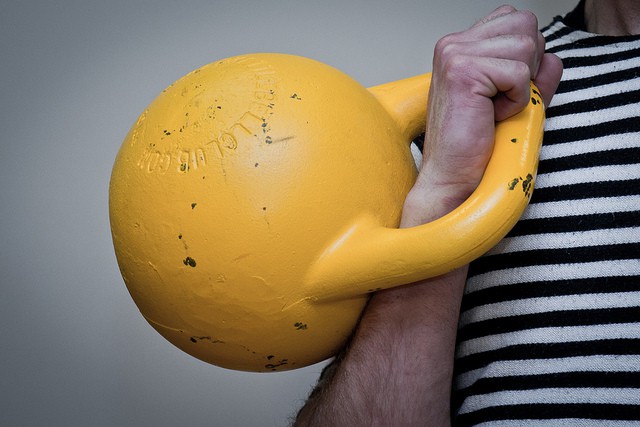In all matters of life, you should seek to increase your efficiency. Fitness and health is no exception.
And fitness minimalism is really and ultimately the intersection between effectiveness (doing the right things) and efficiency (doing things right). To find this point of intersection, you need only ask yourself one single essential question: what is the LEAST amount I can do to reach my goals?
This question, when answered honestly, is a machete, and by it we see exercise programs cut down like grass. The weeds are cleared away, so to speak—we typically see a savings of 80%–and one can then focus their efforts on nurturing what bears the most fruit.
To be lean, strong, and healthy—what is the least we can do to get ourselves there?
Minimalist Fat Loss
300 Kettlebell Swing per day. If you do nothing else, do this.
Performing swings every day, intermittently, and to the grand total of three hundred serves a couple of useful purposes. Primarily, it stokes the metabolic furnace at regular intervals and leaves it burning for long after the exercise is concluded. You do not get the same effect from traditional “cardio” efforts (namely, anything done on a treadmill, elliptical, or stationary bike). If you seek to burn fat efficiently, this is a very good way to do it.
Related: Health Tips from a World-Class Bodybuilder
Secondly, the swing is a marvelous way to strengthen the butt, the hamstrings, and the low back. When done properly, it all at once boosts power, flexibility, and work capacity. Very few other movements come with such well-rounded and enormous benefits as does the kettlebell swing.
300 reps, well, it seems to be the magic number—the Goldilocks number—not too much, not too little, but just right. If you are experienced in the movement, I offer the following prescription. Men use a 24kg; woman, a 16kg.
What is the best way to do your swings? I do not recommend doing them all at once. Instead, chunk it down into sets of 10, 20, or maybe even 50, and work them sporadically throughout the waking hours.
For an added bonus, knock a set or two off right before and after eating to ensure whatever food you take aboard is shuttled off preferentially to hungry muscle tissue, and not promptly converted and deposited as fat.
Related: 7 Best Bodyweight Exercises You Can Do Without Going to the Gym
Minimalist Strength Training
The premise here is this: Pick six lifts and do them (4-5 days per week). Work them with a “heavy” load (a weight that is between your 5-7 rep max) and in the manner of 1,2,3,1,2,3. We keep the reps low so we can go heavy because if we want to get strong, we have to lift heavy at least some of the time. Don’t add reps or exercises. Just add weight when the movement starts to feel light(er).
- Push: Bench press, military press, push up (one arm push up), dip
- Pull: Pull up, chin up, row
- Hinge: Deadlift, single-leg deadlift
- Squat: Front squat, back squat, pistol squat, Bulgarian split squat
- Carry: Turkish Get Up
- Ab: Hanging leg raise, ab wheel, plank
A sample layout might look like this:
- Military press x 1,2,3,1,2,3
- Pull up x 1,2,3,1,2,3
- Deadlift x 1,2,3,1,2,3
- Front squat x 1,2,3,1,2,3
- Turkish get up x 1,2,3,1,2,3
- Hanging leg raise x 1,2,3,1,2,3
Because the density is low, we can bear a relatively high frequency. Meaning, because we do not do too much in any one day, we can lift on multiple consecutive days. But I do recommend the following agenda.
- Monday: On
- Tuesday: On
- Wednesday: Off
- Thursday: On
- Friday: On
- Saturday: Off
- Sunday: Off
The Takeaway
This program, as you can see, is vigorous and concise. It is whittled to the bone, and there is hardly a thing left in it that you can take away without causing harm.
I hope you take it, use it, and get awesome results. If you have any questions, or if I can clarify anything for you, let me know in the comments.
*******************
 Pat Flynn is a fitness expert and author of Paleo Workouts for Dummies (Wiley, 2013) and Fast Diets for Dummies (Wiley, 2013). You can follow Pat at ChroniclesOfStrength.com, a blog on fitness minimalism.
Pat Flynn is a fitness expert and author of Paleo Workouts for Dummies (Wiley, 2013) and Fast Diets for Dummies (Wiley, 2013). You can follow Pat at ChroniclesOfStrength.com, a blog on fitness minimalism.
Image by andrewmalone
Originally published 2/14 and updated 11/14.


1 comment
Hi Pat
I used to do interval training with weights way back when so this looked interesting. I started your Minimalist Strength Training model today. The only question I have for now is what is the rest interval between sets and exercises? For example you have: Military press x 1,2,3,1,2,3, so: 1, (?rest period)2,(?rest period),3, (?rest period) etc and then between the exercises? Thanks
Gary
Comments are closed.